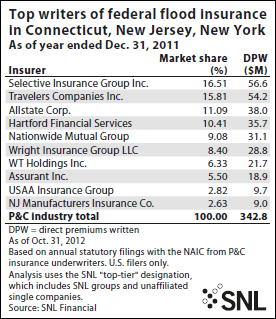While primary insurers will likely shoulder most of the losses from Hurricane Sandy, the reinsurers might not go completely unscathed, based on recent experience.
An analysis of catastrophe losses in the wake of Hurricane Irene, which also affected the New York area, shows that even companies exclusively focused on reinsurance saw at least some losses. Flagstone Reinsurance Holdings SA, for instance, recorded $10.9 million in pretax cat losses from Irene, which made up about one-fifth of its overall cat losses for the quarter.
The ultimate losses borne by reinsurers will depend, of course, on the reinsurance programs in place at the underwriters that wrote policies within the region affected by Sandy.
The NFIP, which is managed by the Federal Emergency Management Agency, has a “Write Your Own” program, under which private insurance companies write federal flood insurance policies in their own names, with FEMA providing the funds for claims. In this way, the NFIP is reinsuring the business, which is how it is reported in the Schedule F filings. Traditional homeowners policies do not cover flood damage, so the NFIP will likely be substantially on the hook from Sandy. The NFIP does not cover auto damage, however, so those losses will remain with the auto insurers.
In total, the U.S. P&C industry wrote about $2.8 billion worth of federal flood direct premiums in 2011, which was down from $3.0 billion in 2010 and $2.9 billion in 2009, according to SNL data. The NFIP has been a political football, in debt to the Treasury by about $18 billion and heavily debated in Congress each time it is up for renewal. David Sampson, president and CEO of the Property and Casualty Insurers Association of America, pointed to this political uncertainty as one of the reasons several WYO carriers have exited the program. Each time the program lapses or is extended for a short period of time, he said, it creates “cumbersome and expensive” bridging transactions, according to remarks prepared for a May hearing of the Senate Banking Committee.
Residents in high-risk flood areas that have mortgages from federally regulated or insured lenders are required to have flood insurance, with “high-risk” defined as areas with a 1% or greater chance of flooding in any given year. Homes and businesses in moderate-to-low risk areas, by contrast, are not required to have flood insurance, but a lender can demand it even if it is not federally required.
In addition to the national totals, SNL examined the amount of federal flood premiums written specifically in Connecticut, New Jersey and New York, given how hard Sandy hit the region. According to SNL data, the industry as whole wrote about $342.8 million of direct premiums in the tri-state area in 2011.
Source: Thomas Mason, SNL Financial
Was this article valuable?
Here are more articles you may enjoy.

 JPMorgan Wins Gender Pay Gap Dispute Against London Analyst
JPMorgan Wins Gender Pay Gap Dispute Against London Analyst  Cyber Breach Affected 750,000 Canadian Investors, Regulator Says
Cyber Breach Affected 750,000 Canadian Investors, Regulator Says  What The Return of California’s ‘Death Discount’ Means for Litigation
What The Return of California’s ‘Death Discount’ Means for Litigation  OpenAI And Microsoft Sued Over Murder-Suicide Blamed on ChatGPT
OpenAI And Microsoft Sued Over Murder-Suicide Blamed on ChatGPT 